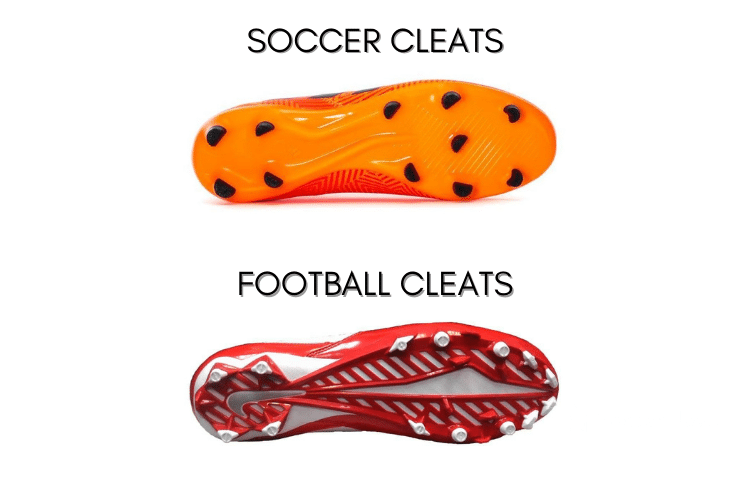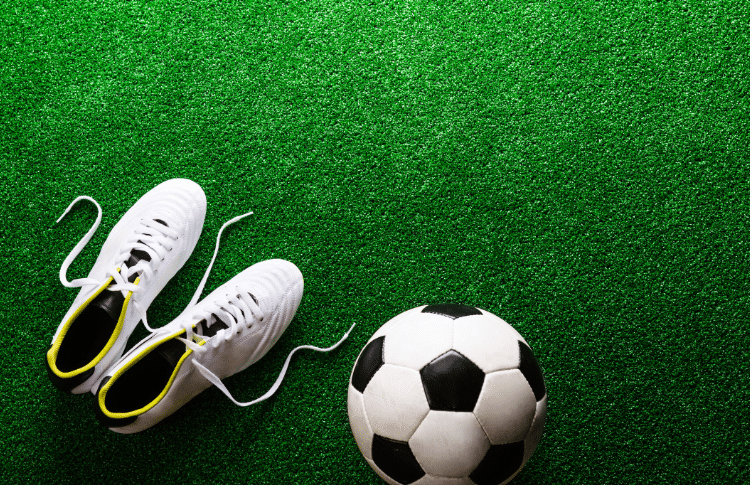What is the Difference Between Football and Soccer Cleats?
What is the difference between football and
From the stud shape to the outer layer of the cleat, the difference can have a significant impact from sport to sport.
Key Takeaways From the Article:
- Soccer cleats are lighter than football cleats because of the speed of play of each sport.
- The studs on the cleats are positioned differently for each sport.
- Soccer cleats are low-cut while football cleats can be low, medium, or high-cut.
In this article, we will examine the difference between football and
Weight of Soccer and Football Cleats
The most significant difference between football cleats and

Football cleats are heavier than
In contrast to football cleats,
The first is that soccer is played with a lot of constant running. Players can run up and down the field for 90 minutes straight with less fatigue if they have lightweight shoes.
While football cleats are typically heavier, the appropriate weight for a player’s cleats changes depending on their position. Receivers and defensive players sometimes prefer lighter, less supporting cleats than players in other football positions like a linesman.
Material of Cleats
Soccer and football cleats are both made of comparable materials. Most of the time, the outer layer is made of leather or a synthetic material. But, they still do have their differences.
Soccer cleats are made from a thinner, more pliable material. The light and pliable materials enhance the touch with the ball. It allows more air to circulate, so the player’s feet don’t get too hot and sticky as they play.
On the other hand, football cleats are built with a stronger upper material to shield players from the rough nature of the game. The cleats can endure more contact and less bending because of the thick materials.
Studs of Soccer & Football Cleats – Design & Layout
Another distinction between soccer and football cleats is the amount and shape of the studs.
The studs on football and
Depending on the brand and style, soccer and football cleats can have studs of varying sizes and configurations. Most of the time, the studs have a square shape.
Football cleats have a higher grip because of their sharper and longer studs than
Aside from the shape, the number of studs is another difference between soccer and football cleats. Comparing football cleats to
You will also notice that football cleats have a spike on the toe. Football toe spikes are necessary because they offer better traction when blocking or stepping forward to escape a tackler. Yet, a soccer cleat doesn’t need a toe spike since it interferes with players’ touch on the ball.

In soccer, cleats have different styles based on the field material. We’ve addressed this in the article ‘Types of Soccer Cleats’.
Midsole of Cleats
Football cleats are designed with an extra midsole. The cushioning layer between the cleat’s outsole and insole is called the midsole. The midsoles of football cleats are often made of phylon.
Football players need a midsole because of the abrasive nature of the sport. It acts as a shock absorber to protect players from getting hurt.
Soccer cleats don’t have a midsole (only insole) and therefore don’t give any additional comfort to the player. It’s because soccer players must maintain a low center of gravity and stay close to the ball, making them more agile.
Agility helps soccer players to move more freely while playing, which improves their performance.
Outsole of Cleats
The outsole is the component of the shoe that makes contact with the ground. Football cleats’ outsoles are more robust and substantial. They’re sturdier, so they can provide better stability on the grass or artificial turf fields.
Soccer cleats’ outsoles are often thinner and lighter. These outsoles help athletes perform better on the field by increasing their agility and quickness.
Given the variances between the two sports’ outsoles, using football cleats for soccer would restrict the movement necessary to be effective.
Overall Design – Soccer vs. Football Cleats
Because soccer players want lightweight footwear, most of the cleats are low-cut. The low-cut style makes it easy for the players to flex their ankles and kick the ball like they want.
In American football, there are three types of football cleats: low, mid, and high cut. The low-cut style is comparable to a typical soccer cleat, while the mid-cut and high-cut styles are comparable to basketball sneakers.
Each style of football cleat has its benefits. The low-cut model boosts players’ speed, while the mid-cut model provides both speed and ankle support. Football cleats with a high ankle cut offer support for the ankle which is ideal for lineman.
Conclusion
I hope that helps you understand the difference between football and soccer cleats.
Just know that there is a difference and players shouldn’t be using football cleats for soccer.
The stud design and layout allow players to continuously run and cut on the soccer field without digging too much into the ground.
If you are in the market for new boots (cleats) for soccer, I suggest sticking with a firm ground (FG) type of footwear. There are some great options that we’ve recently reviewed.
Common Questions
Technically, players can get away with it but it’s not recommended. As you learned, there are differences between each that affect the performance.
Again, it is not recommended. Football cleats tend to be more rigid which will affect the performance on the field. Additionally, some refs will not allow players to wear football cleats at all.
There are no toe studs in
Yes! Many youth players will wear

Written By: SoccerNovo
SoccerNovo is an independent youth soccer media brand built to help parents, players, and coaches better understand the game and the pathways available in U.S. soccer. Our mission is to make youth soccer simpler, clearer, and more accessible for everyone involved in it.
Let’s connect





